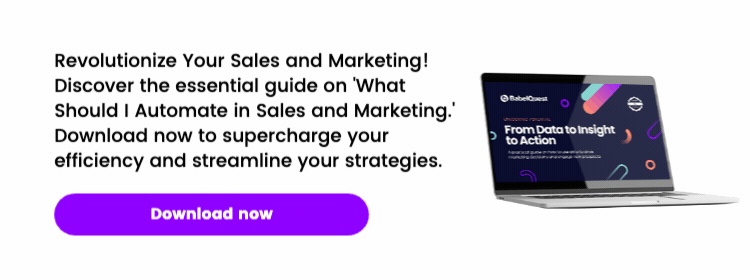New conversation automation (workflows based on Conversation events in HubSpot Pro and Enterprise) automates repetitive manual tasks while helping to keep your costs down.
Ask most business leaders about their objectives, and one of the first words out of their mouths will be "growth".
But as your organisation scales, the work to maintain that growth piles up, and if there are holes in any of your operations, you’ll quickly know about it.
“When your operations are small, you can get away with having a few holes in them. Your operations manager has 10 fingers they can plug them with, right? Then you scale, and five holes become 10. Still, your operations manager can just about manage. After your next growth spurt, you have 20 holes to plug. By this point, inefficiencies have built up and people across the business are scrambling to understand where they came from — and how to fix them.”
Even the most capable operations managers can’t be everywhere at once. As a result, friction multiplies as your organisation scales until eventually, it spills into customer-facing functions like sales and marketing, and your customer experiences takes a hit.
Automation can solve all this, providing a solid, scalable foundation for growth — but it needs to be implemented correctly. Read on to discover:
- what this looks like in practice
- when HubSpot’s conversation automation helps
- how to get the most out of automation for your organisation
How automation drives scalable growth
Automation is key to growth because it allows you to take a winning formula and multiply it many times over. The secret’s out and 74% of organisations say they want more of it.
But automation only works like this if you first connect it to all of those non-linear touchpoints.
What do we mean by this?
From new prospect to brand advocate, every one of your customers goes on a journey with you. We call this the buyer’s journey, and it means that as your prospects move along the journey towards becoming a buyer, they’ll interact with all your customer-facing teams.
Automation can serve them at every point, but if it’s siloed from the wider operational structure, it’s not going to work well. It doesn’t know what your buyers are interested in or which other workflows they’re enrolled in. As you can imagine, it will quickly get messy.
“Lots of companies struggle with automation for that exact reason. It isn’t aligned across their sales, marketing and services functions, and it isn’t synced with their single biggest source of truth: your contact records.”
Why do so many businesses find themselves in this situation?
For one, there’s the perception that automation is a quick fix. Done right, of course, it’s exactly that — but the groundwork has to be there for it to work across the buyer’s journey.
The second reason is the sheer breadth of automation solutions available.
Automation vendors span the entire customer experience spectrum, and as teams scale, each selects their favourite app, causing major silos and reducing the automation’s overall impact.
Silos are bad. This is what we mean when we talk about different customer-facing functions like marketing and sales setting up their own independent workflows. Individually, the automation at play may be perfectly fine for that function — but because they don’t take other function’s into account, they create poor alignment, incomplete insights and make it very difficult to see what’s working and what isn’t working as you scale.
“Imagine you're selling and marketing a product but there are none in stock. (Another system has that data.) The marketing and sales automation carries on regardless, creating friction when you then have to inform the customer that you can’t deliver.”
Your operations manager will be pulling their hair out, but there’s someone else who suffers through all this, and it’s the person you’re setting up the automation for in the first place.
Okay, so what is conversation automation?
Conversations is a tool in HubSpot that enables you and your teams to view, manage, and reply to incoming messages from multiple channels. Here’s where it gets exciting:
“You can triage messages sent via email address, Facebook, or your website in one unified inbox. You can also create tickets from each conversation to track a visitor's experience with your business.” ‘Overview of the conversations tool’, HubSpot
Already, you can see how collating all these communications in one inbox can help to break down the "silo" effect. At any time, marketing, sales or service could dive into the inbox, read an email and get a fuller, more accurate picture of that buyer’s situation.
Conversation automation, then, is simply the process of automating those interactions, so you can respond to something a prospect or customer has asked of your organisation. Think ‘one seamless conversational workflow’, instead of three action-driven workflows that overlap, conflict, or plain confuse.
- This way, conversation automation streamlines the user experience, whichever stage your prospect or customer is at.
- It gets rid of 90% of the manual, time-consuming actions that are boring and repetitive.
- It removes the costs and inefficiencies we talked about earlier (the ones associated with disconnected data).
Already a user? Discover how to create a conversations inbox and connect team emails/channels.
Embrace programmable automation through HubSpot
If the siloed approach to automation that we described earlier is familiar, don’t worry — you’re not alone. Most businesses take this approach by default because up until now, there hasn’t really been a viable alternative.
Others have turned to big, bulky technical automation software to try and solve these problems, but those come with challenges of their own.
- For one, they take time to set up.
- Another is that they often need specialist help just to maintain them.
- Both of these issues makes this a costly option.
To go back to our earlier analogy, they’re causing as many holes as they’re filling. To top it off, if you want to change one thing, you need to think about how that impacts all other elements in your process. Haven’t you got enough on your mind already?
This is where the HubSpot platform and programmable automation really shine.
HubSpot isn’t just an automation specialist, it’s a complete customer experience automation platform that allows you to do more — without the downsides of traditional automation. Even existing users, who up until now have only had access to automation that HubSpot has created on the basis of what it thinks might be helpful, will be impressed with its advances.
Programmable automation means being able to build your own custom workflows where you can code the logic in.
Now, if you’re on HubSpot Pro or Enterprise, you can benefit from being able to
- send requests to third-party apps
- ring back data
- completely customise every aspect of your workflows
All of this is delivered by
- custom-coded workflows
- custom coded chatbot actions
- web-hooks in workflows
Best of all, because of HubSpot’s advanced logic, all those third-party apps and the integrations that your teams depend on day after day connect directly with HubSpot for a seamless experience, creating powerful new automation for marketing, sales, services and operations.
To help you grow, update your automation as you go
Your automation should scale with your business, not hinder it. So instead of relying on standalone workflows, siloed automation and clunky software, trying looking at how you can:
- align the data across your teams to create end-to-end automation and experiences
- adopt intuitive, easy to manage automation software, getting you up and running in no time
- adapt your customer experience and business processes as your team scales and the market changes using programmable automation
One of HubSpot’s defining qualities is how simple it is to use, but sometimes organisations with especially complex operations or data requirements will benefit from a little help.
As an Elite HubSpot Solutions Partner with extensive experience helping B2B businesses unlock the full potential of the HubSpot platform, BabelQuest is on hand to support you however we can. Whether your challenge is around data management, the configuration of the HubSpot software or sales strategy, our Expert Practices team can help you to adapt your HubSpot setup to meet the needs of your customers and the teams that serve them.
“HubSpot’s Advanced Implementation Certification (AIC) isn’t just a new badge. It’s recognition of our long-standing capabilities in advanced HubSpot implementations for complex clients.” ‘BabelQuest Opens Up the UK Market for Complex CRM Implementations’, Eric Murphy, Head of Revenue, BabelQuest
Develop your team’s in-house skills using our comprehensive training courses, or book us for recurring monthly support in the form of our HubSpot Support Service, giving you access to our world-renowned experts and Certified trainers for hands-on help and advice.
Your operations manager can’t be everywhere at once. But with HubSpot’s latest advances in conversation automation and a partner such as BabelQuest by your side, they don’t have to be. Unlock the platform’s full value by making the most of its newest automation features and watch as your organisation grows better.
To find out more about automation and how your business could benefit, click the image below to download our guide to automation blueprints.
Heading
Separated they live in Bookmarksgrove right at the coast of the famous Semantics, large language ocean and many more stuff and more more more


Vaughn Armstrong is a Director at BabelQuest, an Elite-tier UK HubSpot Solutions Partner.



.png?width=50)

.png?width=50)
.png?width=50)



































